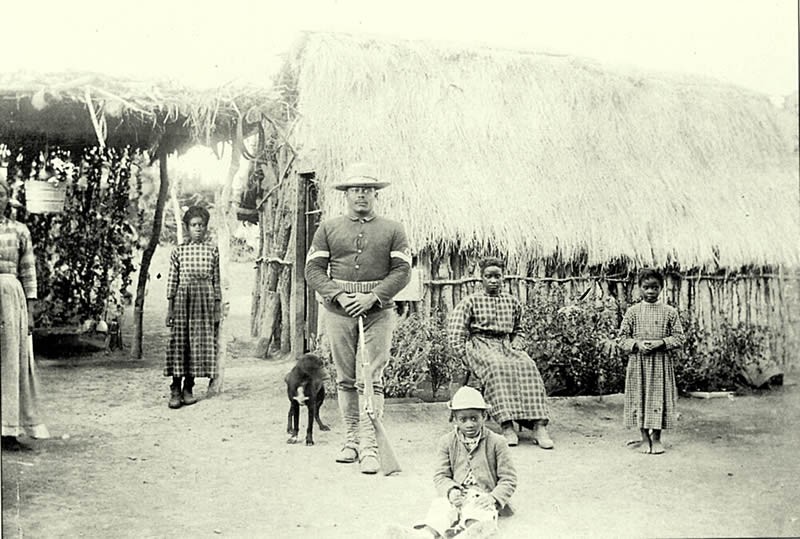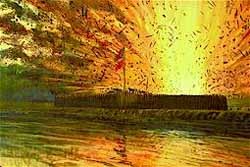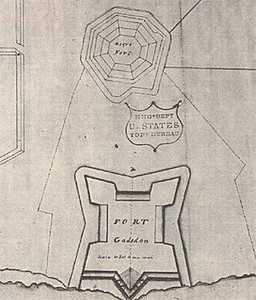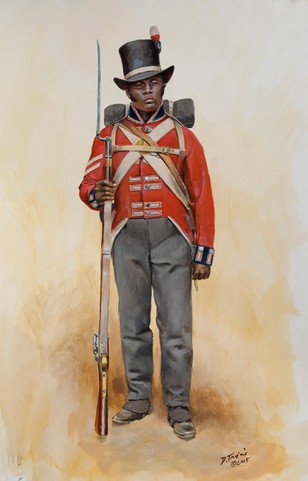Battle of Negro Fort
Introduction
Text-to-speech Audio
Images
"Warriors from Bondage," by Jackson Walker

African American Seminole Indian Scouts

Painting of the magazine explosion at the Fort

An American map of the later Fort Gadsden next to the older Negro Fort

A soldier in the "Corps of Colonial Marines," a regiment of free citizens of Florida and ex-slaves who fought alongside the British in the War of 1812.

Backstory and Context
Text-to-speech Audio
Early History of the Fort Gadsden Historic Site
The earliest fort on the Fort Gadsden Historic Site was built during the final year of the War of 1812. The quick construction of the fort came from the British’s desire to open a southern front against the United States and enact a prompt invasion of the Gulf Coast. British Captain George Woodbine arrived at the mouth of the Apalachicola River in 1814, under orders of opening contact with and providing arms and ammunition to the thousands of Red Stick warriors who had fled to Florida due to their losses in the Creek War of 1813-1814. About 30 miles up the Apalachicola River, at Prospect Bluff, Woodbine collaborated with the British-owned Forbes & Company trading post to distribute military supplies to the allied Red Sticks and Seminoles.
Following the establishment of the post at Prospect Bluff, British Major Edward Nicolls began supervising the construction of a fortification, and once completed, the Fort held over a fighting force of over 2,000 Red Stick, Seminole, and Choctaw warriors. Woodbine, Nicolls, and other British officers also assembled a fighting force comprised of 100 African American soldiers, most of whom were free Black citizens of Florida, though some had been slaves
The Battle of Negro Fort
Once the British had left, many of the Red Stick, Seminole, and Choctaw warriors returned to their villages. However, Garcon and a force of 100 Black soldiers continued to defend the Fort and live there with their families. Soon, the Fort became the focal point of a settlement of free Blacks, which caused significant concern for plantation owners in the South, as well as the American government. Consequently, the U.S.
Frustrated by the delay, the American government authorized Major General Edmund P. Gaines to take care of the Fort. The operation was led by Lieutenant Colonel Duncan L. Clinch, and in July 1816, 112 soldiers from the 4th U.S. Infantry and a regiment of several hundred Creek warriors marched down the Apalachicola River, eventually surrounding what they called, “Negro Fort.” Clinch demanded surrender, but Garcon refused and responded with a shot from one of the Fort’s heavier cannons. Garcon had his men raise the English Jack flag as well as a red (“bloody”) flag.
On July 27th, 1816, the Battle of Negro Fort began. Clinch boasted support of the U.S. Navy, and Gunboats #149 and #154 were moved in
The result of the short battle influenced Florida warfare over much of the 19th century. Seminoles anger at the U.S.
The Fort Today
Following the Battle of Negro Fort, General Andrew Jackson directed James Gadsden to rebuild the Fort in 1818. The Fort was a forward base for army movements during the First Seminole Wars, as well as the Second Seminole Wars. During the Civil War, Fort Gadsden was under Confederate control until 1863, as it was abandoned due to a malaria outbreak.
For the next
Nowadays, visitors can explore the earthwork remains of the Fort, as well as traces of “Negro Fort,” a cemetery, interpretive signage, a mini-museum, and a network of hiking trails and other amenities.3
